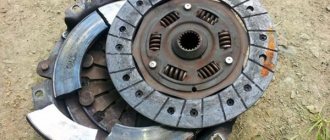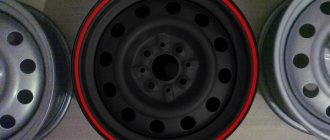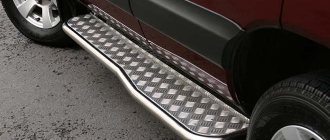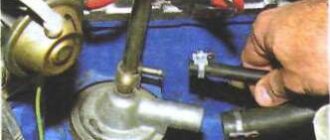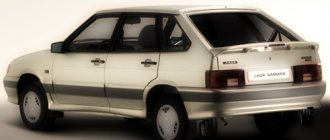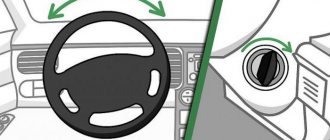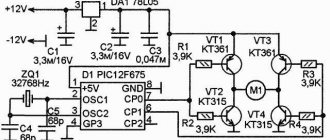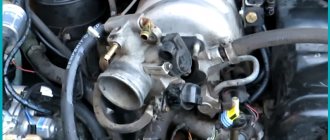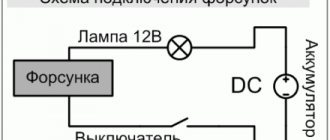The paint chips on your car can be large or small. Exposed metal can lead to rust, which can spread underneath the paint and destroy entire parts of your car's body. Even a small chip in your paint caused by tiny pebbles can cause major headaches if you don't fix it properly. Luckily, most chips can be repaired at home with minimal tools and experience. You may not be able to restore your car to its original condition, but you can prevent rust from developing and even repair a chip so well that most people will never notice it.
Car paint chip repair
Buy a tinting pen. Unlike scratches, which can often be sanded or wet sanded, a chip in the finish will require new paint to be applied to the metal. The paint on your car doesn't just make it look good, it also protects the metal underneath from the elements. If metal is exposed to air and moisture for too long, it will begin to oxidize and rust. Using touch-up paint can help you prevent rust, and with the wide variety of options available, it'll be easy to find a color that matches your vehicle exactly. Scratch touch-up pens are designed specifically for small chips and can be very easy to use.
Check the sticker inside the door of all cars built after 1983 for the paint code. If the code is not clearly marked, take a photo of the sticker to show the salesperson at your local auto parts store so they can find the code.
Some shops may ask for the Vehicle Identification Number (or VIN) for your vehicle to ensure they can find an exact match for your paint. Your VIN can also be found on a sticker inside your door or on the vehicle's registration document.
Clean the area around the chip. Before you begin painting, it is important to clean the area thoroughly. Painting without removing dirt can ruin the appearance of the car. Rinse the area, wash it with warm soap and water, then rinse again, and then dry well.
Make sure the car is completely dry before applying paint.
Selecting suitable materials
First you need to determine the degree of damage and its scale. The choice of material depends on the nature of the defect:
- small scratch or chip - buy a small bottle of touch-up paint, along with degreaser, primer, varnish in the same quantity;
- medium defects, or it is necessary to restore an entire body element - you will need a 520 ml aerosol can of primer and paint;
- significant disadvantages - cans of professional paint, primer, varnish with a capacity of 1 liter or more.
Tints from aerosol cans have the same characteristics as professional paints. To select the color of the material, you should use the car's VIN code or paint code. An effective option is computer shade selection. It is good if the body has darkened, faded or been repainted before. If in the latter case enamel made according to the international RAL standard was used, the process will go faster.
Car chip repair
Use a marker to fill in the chip. Once the machine is completely dry, remove the cap from the handle and place the tip of the handle in the center of the chip. Depending on the type of marker you are using, you may need to press the nib down slightly to release the ink. You may not need to move the handle to fill a small chip as the substance will be released and should fill the required space, but move the handle slightly from side to side if you need to release more. Use enough to overfill the chip a little, as the paint will dry out a little when it dries.
Don't apply too much so it doesn't drip. The color will match, but things like the drips will stand out. If you accidentally apply too much paint, remove the excess immediately and thoroughly.
Repairing chips and scratches on a car body
Let the paint dry, then wash and wax the car. Make sure it's completely dry before washing your car, as you can easily scratch or damage the new coating while it's sticky. Depending on the type of pen and how much you used, it may only take about an hour to dry completely, but it can take a full day. Once the paint is completely dry, wash the entire car and then apply a new coat of wax.
Lightly touch the surface to determine if it is dry. If you feel that it is sticky, it means it has not dried yet and you should wait a little longer. Applying a new coat of wax will help give your car's paint a consistent color and shine, and will also help protect it from further chipping.
Remove any debris. Medium-sized chips tend to be between the size of a dime and a quarter. Due to their increased size, small amounts of debris may become lodged in the chip or paint at the edges of the chip. Remove small debris with your fingers or tweezers before washing an area of the car. If you try to wash the damaged area first, the sponge may catch small chips and drag them through the rest of the good paint, resulting in small scratches.
Using tweezers can help you remove small shards that may be embedded in the paint before you wash your car.
Sometimes blowing into the area or using canned air can release and disperse small debris.
Make sure the paint doesn't peel off when removing debris. Peeling can result in large amounts of chips.
How is tint used?
Chips and scratches are not always noticeable, but their appearance has a negative impact on the condition of the car. The paint coating performs a protective function. Deep damage gradually rusts, and then repairing them will be very expensive.
How to properly touch up chips on a car? The technology is as follows:
- Inspect the surface, assess the scale of the work. If the paint layer is not damaged, you can use abrasive polishing.
- The area to be repaired must be washed and dried.
- In addition to removing rust, use acidic or etching primers. Then, for better adhesion, you will need a metal primer.
- The cleaned area is degreased. There are tools designed specifically for this.
If you doubt the safety of a degreaser, or are not using a special liquid, test the material first. Apply a small amount to a rag and wipe the most inconspicuous area of the body. Do you see traces of coating on the rag, or notice that it has been painted to match the color of the car? This means that the wrong liquid was chosen.
The best option is solvent or alcohol formulations. Petroleum products and aggressive solvents will only harm the vehicle.
If you choose to apply a bottle of paint with a brush, shake the container well first. Using a brush, smoothly and evenly fill the defect throughout its entire depth. Try not to do this for long, because one-component tinting compounds set quickly.
In modern body paints and varnishes there are no NC enamel. Buy methacrylic or urethane compounds, the use of which involves a two-layer arrangement. First the base coat (paint) is applied, then the varnish.
If the kit contains a brush that is too large, you will not be able to accurately paint over the defect. It is better to use another brush, or simply cut off the excess fibers.
After completion, inspect the treated areas. Poorly painted areas are cleaned of undried paint composition with solvents or degreasers. Then the painting procedure must be repeated.
Do-it-yourself chip repair on a car
Wash the area around the chip. Once there is no debris left on the chip or its surroundings, wash that part of the car again. Wash the area first, then apply warm soapy water with a sponge, and then rinse again. Make sure the car is completely dry before applying paint.
Washing the area also ensures that there is no debris or deposits that could get caught in the new coats of paint.
Use alcohol to remove grease and oil. Once the area around the chip is clean and dry, apply some rubbing alcohol or enamel thinner to a rag and use it to clean the chip. This will remove any grease or oils in the area that may be making it difficult for the primer to form a strong bond with the metal. You most likely won't be able to see the oil or grease, but it doesn't have to be visible to compromise the painting process. Simply wipe with a rag on the chip itself and around its edges.
Remember that this will remove wax and even clean up any remaining paint, so avoid scrubbing the painted area. Instead, simply rub the chip lightly.
How to remove chips on a car
Apply primer to metal. The primer comes in a small bottle with a brush, as opposed to a paint pen used for smaller chips. Use an applicator brush to apply the primer to dry, clean metal, taking care to apply very little of it to the paint surrounding it. Use only enough primer to cover the unpainted area with a thin but firm coat.
While you're painting over the primer, applying it to the paint around the chip will raise the coating height in that area, creating a spot in the paint that you can see.
Make sure the primer is completely dry before moving on to the next step. If it seems sticky, it means it hasn't dried yet.
Competent repair of chips on the hood
Apply the tint by smearing the applicator. Medium and large chips require touch-up; it is best to do this with an applicator brush. Although the paint is the same, the method used to apply it is slightly different. For medium-sized chips, a touch-up pen can still help. Shake the touch-up paint thoroughly, then dip only the applicator tip into it. Apply the fingering brush to the center of the chip and move it slightly, allowing the paint to adhere to the metal and expand. Lower the brush again, then touch the paint to the same area, allowing it to flow off the applicator brush and settle onto the vehicle instead of smearing it like you would when painting a house.
It may take a few strokes to fill the chip, but doing it this way allows the paint to apply evenly.
Resist the urge to apply more to speed up the process. Adding too much paint at once may cause dripping or bubbling.
Let it dry and reapply if necessary. Once it dries, evaluate the result. If the paint has sufficiently filled the chip and the sides of the touched-up areas are flush with the surrounding paint, you are ready to move on to the next step. If the touch-up paint settles a little lower than the surrounding layer, or some metal is still visible, apply another coat of paint, working it over the chip as you did before.
The paint may appear lifted from its surroundings when you apply it. As it dries, it shrinks, allowing it to level out.
Patience during this process will ensure you have the best possible final product.
Make sure the touch-up paint is completely dry before moving on to the next step (this may take several hours).
Waxing after painting the chipped area
Wash and wax your car. Even though you've only painted one small part of the car, it's important to wax the entire car at the same time to ensure an even gloss of the paint. Wax protects your paint from fading and from fading in the sun, so if you don't apply new wax to the entire car, it could cause it to fade to slightly different shades. You will need to apply wax to the newly painted area to protect the new paint and also to ensure its gloss matches the rest of the car.
Be sure to wash and wax the entire car to protect the paint and ensure gloss levels are maintained.
Preparing to repair large paint chips
Assess the damage. Large chips are usually 2 centimeters in size or even larger. Large chips can be the most difficult to repair because the area you will need to repaint will be more visible. If the damage is several inches in diameter or continues to spread larger and larger, you will likely need a body shop to repaint the entire body component or even the entire vehicle. Before you begin, make sure you can handle the damage.
Paint should only be used on chips that are smaller than a few inches in diameter.
Use tweezers or a toothpick to remove debris and chips. Larger chips are more likely to accumulate debris, which you must remove before moving on to the next step. Use your fingers or tweezers to remove any large debris, and try blowing on the area or using compressed air to remove any debris. Large chips can cause paint to peel off. Make sure you remove the old one that is peeling off as it is no longer bonded to the metal and will eventually come off anyway. You can use your fingernails, tweezers, or a toothpick to remove flakes from your car's peeling paint.
Be careful not to remove good paint from the area surrounding the chip when removing the flakes.
Make sure you don't scratch the good layer with the tools you use to remove flakes or debris.
Let's sum it up
The body repair process is always complex and requires maximum concentration from the performer. But quality work brings excellent results. It is much easier and better to repair chips before they become the cause of more serious problems with the body. If you notice a chip in the paintwork of your car, you should immediately begin to repair it. Then you will be able to remove the problem in a few minutes.
As you can see, you can easily do without the expensive help of professionals and paint over the chips yourself. Are there any drivers among our readers who have performed body repairs themselves? It will be instructive and interesting to read more practical tips.
Repairing paintwork in places where paint has chipped on a car body
Remove any rust in and around the chip. Since large chips receive more moisture from contacting the metal, there is an increased risk of rust. Remove rust by applying some special rust removers to the car body. If the rust has penetrated deep enough to create a hole in the door, or has penetrated deep enough into the metal to create a hole, it means that the rust has destroyed a body part and cannot be corrected by simply painting over it. An auto body repair shop can determine if this amount of rust can be removed and repaired, or if this vehicle body component needs to be replaced. If there is no deep penetration of rust, simply apply rust cleaning products.
Wipe the area where you applied the anti-rust with alcohol to remove the chemical and any grease or oil that may remain.
If the rust is not completely removed, the new paint you apply will peel off the rust.
Stopping the spread of rust can save you costly auto body repairs in the future.
Finishing
The surface around the pimple is painted with any easily washable paint. For example, water-dispersed. This will allow you to accurately control the position of the abrasive stone and not sand off anything that shouldn’t.
First, take abrasive paper P1500. It is fixed on a small wooden block the size of a matchbox and slightly wetted. Sand the bump until streaks appear on the surface of the control paint. Check the quality of work by running your finger along the tubercle. Ideally, you should not feel the difference between it and the rest of the surface.
The protective paint is washed off, the 1500 sandpaper is replaced with P2000, which finally smoothes out the protrusion. The surface remains matte. Polishing is done with a paste applied to a soft cloth made of natural material. For example, flannel, flannel, felt. A felt buffing pad is too rough for this job.
The technology offered by Nussle is a long and painstaking process. But your time and energy will not be wasted. The location of the former chip is no different from the rest of the body surface.
Even significant chips on the hood can be removed if you pay attention to them in a timely manner and select appropriate methods to eliminate them. This will prevent the formation of rust and serious damage to the paintwork.
Grinding a chip on a car body before painting
Sand the edges of the chip. Use fine-grit sandpaper (2,000 grit should be enough without causing additional scratches) to round the edges around the chip to reduce visibility after the repair. By rounding out the edges of the chip by sanding, you can help the new paint blend with the old more effectively so that the touch-up area becomes completely invisible. Do not wet the sandpaper as you would with wet sanding, as this may cause rust to form on the bare metal. Instead, use dry sandpaper and replace it frequently as the paper becomes clogged with paint.
Taping pieces of sandpaper to small handles or pieces of wood squares can help you control the angle at which you sand, but this step is not necessary.
Sand the edges of the chip until they are rounded and not visible to the naked eye.
Wash the area after sanding to remove any new residue left behind from sanding.
The chip caused rust
If damage to the paintwork is ignored for a long time, metal corrosion occurs. You cannot remove rust from a body with a pencil. If corrosion appears, you will need to remove it, and only after that, begin to eliminate chips. The algorithm of work performed is as follows:
- The damaged area is cleaned down to metal. This applies to both large and small damage.
- The area affected by rust is treated with a corrosion neutralizer and degreased.
- A primer is applied to the surface, sanded, coated with paint and polished.
If there are dents, they must be removed. To do this, use special pulling devices and automotive putty.
Repainting large chips on the body or how to remove deep chips on a car
Apply primer. Once the chip has been sanded, cleaned and dried, you can apply primer in the same way as you would on a medium-sized chip. Apply a thin coat of primer to any bare metal using an applicator. Be careful not to apply so much primer that drips start to form, as they could reach the paint or cause the final repair to look uneven.
Allow the primer to dry completely before moving on to the next step.
It may take several hours for the primer to dry completely. Read the label on the car primer you purchased to be sure.
Once the primer dries, it may appear textured due to the bristles of the brush or the way it has settled onto the metal. To sand the primer, use 2000 grit sandpaper and a hose. Turn on the water and hold the hose over the chip so the water flows directly onto the dry primer, then use sandpaper to lightly sand just the primer. Be careful not to sand the clearcoat or paint off the surrounding area, sand until it is completely flat.
Wet sanding the primer will help ensure a smooth surface.
Allow the sanded primer to dry completely again before moving on to the next step.
Do-it-yourself touch-up of chips
Apply paint over primer. Using the same method as for medium-sized chips. Apply the applicator brush to the paint, then touch the center of the chip and let the paint spread evenly. Repeat this process until you have covered the entire primed area. You may need to apply several coats, or one coat may be sufficient depending on the paint you purchase.
Let it dry completely before applying another coat.
If you try to apply it before the primer has dried from wet sanding, it may end up with gray swirls.
Once it's completely dry, repeat the wet sanding process with fresh paint to remove any texture and make it completely smooth. Make sure you use another extremely fine sandpaper (2000 grit or more). Dry sanding will result in scratches on the surface.
If you make a mistake or find a problem with the paint while wet sanding, let it dry completely and then apply another coat.
Lightly sand the area until it is completely level.
Material application process
To perform repairs efficiently and achieve lasting results, you need to use several devices. This is a primer for plastic or metal, degreaser, varnish, paint. If the body defects are small, 60 ml bottles are sufficient.
How to properly touch up chips on a car? The order of work is as follows:
- To remove grease and dirt from the surface, you need to apply a degreaser. If you neglect this procedure, you may encounter peeling of the coating. Traces of corrosion are removed with special rust converters or fine-grained abrasives.
- Deep defects are primed after degreasing - this is necessary for protection against corrosion and good paint adhesion. Plastic parts require a specialized primer.
- The compositions are applied with a special brush. Materials must be distributed evenly. Residues are wiped off with light movements and a rag. If several layers are applied, you need to take 15 minutes breaks between them.
All that remains is to cover the treated and pre-degreased area with varnish. So, it will naturally shine and acquire an aesthetic appearance. You should start varnishing only after the paint has completely dried.
How to coat a car with varnish in the area of a chip after repair and painting
Some touch-up paint will come with a small container of clear coat, but you may need to purchase this separately. The clear coat is varnish based and should be applied in a thin layer over fresh paint using the included brush applicator. A small brush with fine bristles will also work. Applying a clear coat to the new paint will protect it and give it a healthy shine that will blend with the surrounding paint color and the wax in the next step.
Apply clear coat by brushing a thin layer over the new paint.
A freshly painted chip may still be slightly visible to you, but it will be difficult to see unless you are very close.
Let the clear coat dry completely before moving on.
Treating the car with wax in places of chips after repair and painting
Wash and wax the entire car. Once the repaired area is completely dry, wash and wax the entire car to ensure even distribution of the wax. Waxing the car will further blend the freshly painted area into the surrounding paint and make the repair even less noticeable. You may want to wait a few days before waxing to ensure that the repaired layers of clear coat, paint, and primer are completely dry, so you don't risk damaging the new paint during the waxing process.
https://www.youtube.com/watch?v=9teEltBQ-zo
Tools for repairing chips
To eliminate defects on the body, special kits are sold in car dealerships. They include primer, paint and varnish, and coating brushes. The kit for repairing chips on the body has a large assortment of colors and allows you to repair almost any defects and scratches.
If you find minor damage to the car body, you should not ignore it. Careful handling of the machine, as well as timely repairs, will keep the paintwork of the machine in good condition for more than 10 years.
Source
